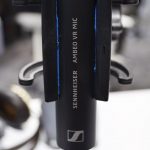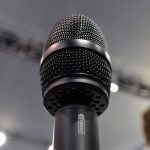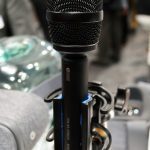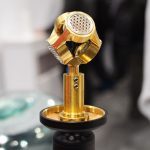Here’s a close look at Sennheiser’s new AMBEO VR microphone in all its glory as demonstrated at last week’s CES 2017 in Las Vegas. It’s the company’s first step into VR audio and it’s just received wide release for a cool $1700.
One of the most respected audio companies worldwide, Sennheiser is best known for its high-end headphones and microphones, which it’s been producing now for over 70 years. So when a company like Sennheiser launches a product for for the immersive media and VR space, people tend to take notice.
 The AMBEO VR Mic is the company’s first foray into 3D audio and is an effort by Sennheiser to make the recording device as transparent as possible – that is, present the user with a convincing reproduction of a 3D soundscape.
The AMBEO VR Mic is the company’s first foray into 3D audio and is an effort by Sennheiser to make the recording device as transparent as possible – that is, present the user with a convincing reproduction of a 3D soundscape.
The device was actually unveiled at last year’s CES, but only became widely available last November, for the princely sum of $1700. For that you get the AMBEO VR Mic itself, a set of balanced XLR cables, Rycote suspension mount, Foam wind shield and access to the company’s proprietary A-B format encoder. It’s this last item which gives a peek at how Sennheiser’s VR audio ambitions are not ending at just the hardware. “For us, Ambeo is the umbrella … for different types of immersive audio configurations,” Sennheiser Co-CEO Dr. Andreas Sennheiser told Digital Trends at CES last year. “And that is from the recording side, to the processing side, to the playback side. There’s playback in 9.1, there’s playback over headphones, there’s recording with VR mics which capture the sound from the signal source, and there’s recordings which capture the sphere differently. Ambeo is a stream of different technologies and configurations which, in the end, should do nothing less than raise the hairs on your back.”
Below is a close up look at what $1700 buys you and you can check out the technical specification of the mic of after the gallery.
Sennheiser AMBEO VR Mic Specs
| Dimensions | 215 x 49/25 mm (L x D) |
| Frequency | response 20 Hz to 20 kHz |
| Max. | sound pressure level 130 dB(A) for 1 kHz |
| Transducer principle | Pre-polarized condenser microphone |
| Weight | 400 g |
| Microphone connector | DIN12M, use enclosed adapter cable to convert to 4x XLR3M Polarity: Pin1 (GND), Pin2 (+), Pin3 (-) |
| Pick-up pattern | 4x cardioid, in A-format arrangement (1: front-left-up [FLU], 2: front-right-down [FRD], 3: back-left-down [BLD], 4: back-right-up [BRU]) |
| Nominal impedance | Approx. 200 O |
| Min. terminating impedance | 1000 O |
| Equivalent noise level | 18 dB-A as per IEC 61672-1 / 27 dB CCIR as per CCIR 468-3 |
| Power supply | 4x phantom powering (P48) as per IEC 61938 (48 ± 4 V), 7 mA each |
| Sensitivity | 31 mV/Pa (-30 dBV) |
| Matrix reference | Center of the capsule holder |
| Mixing to B-format | W = FLU + FRD + BLD + BRU / X = FLU + FRD – BLD – BRU / Y = FLU – FRD + BLD – BRU / Z = FLU – FRD – BLD + BRU |












